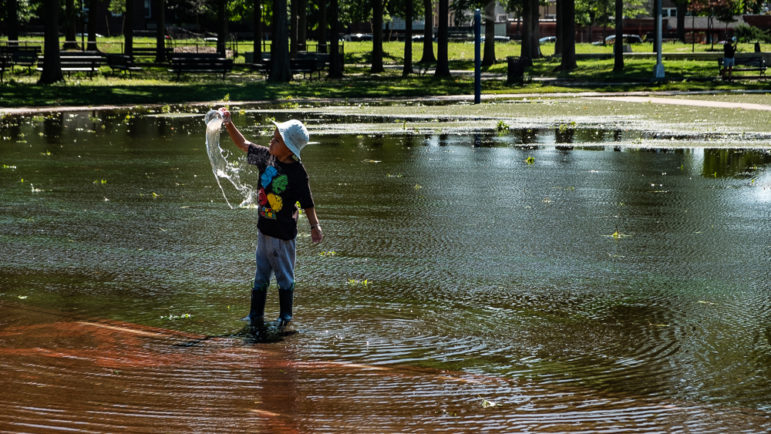The ‘Rainfall Ready NYC’ plan unveiled last week offers short-term fixes to fortify the city against intense rain, as the administration continues to work on a more comprehensive long-term plan, Department of Environmental Protection (DEP) commissioner Rohit Aggarwala told City Limits.

Adi Talwar
Williamsbridge Oval Park on the morning of Sep.r 2nd after a night of record breaking rainfall in New York City caused by the remnants of Hurricane Ida.The Adams administration released a plan Thursday to address heavy rainfall in the immediate lead-up to and aftermath of an extreme weather event—nearly a year after Hurricane Ida, when flash-flooding took the lives of 13 New Yorkers.
As part of the new initiative, dubbed Rainfall Ready NYC, the city updated its flood maps and outlined its response and recovery plan for an extreme storm. It also committed to short-term mitigation efforts, including installing warning signs, completing sewer projects and adding green infrastructure to help manage stormwater.
The announcement comes as the one-year anniversary of Hurricane Ida approaches this September. And October will mark a decade since Superstorm Sandy killed more than 40 New York City residents and caused an estimated $19 billion in damages and lost economic activity, according to city data.
The plan includes links to the new flood zone maps as well as information and advice for homeowners and tenants about how to prepare for storms (among them: developing communication and evacuation plans, clearing trash and debris from catch basins that block the sewer system and acquiring flood-specific insurance).
For its part under the initiative, the city will conduct outreach to property owners as well as basement apartment tenants—who bore the brunt of deadly flooding during Ida. Agencies will distribute sandbags and other flood-protection barriers, and install warning signs at dozens of chronically flooded streets, among other actions.
Department of Environmental Protection (DEP) Commissioner Rohit Aggarwala told City Limits that the Rainfall Ready plan is a “Band-aid” solution, meant to supplement, not replace, a future long-term plan to address extreme weather and resulting flooding.
“[Mayor Eric Adams] endorsed the fact that dealing with the short term is actually more urgent, which is why the short term Band-aid focus of Rainfall Ready took priority because that’s hopefully going to help New Yorkers this hurricane season, this storm season,” said Aggarwala. “But we don’t see that at all as a substitute for a more comprehensive plan.”
Another independent report released the day before emphasizes an adjacent need for long-term planning related to flooding, and highlights blind spots in the city’s efforts to increase naturally protective green infrastructure.
Rebuild by Design and One Architecture & Urbanism published “Toward a Rainproof NYC,” addressing how the city can improve stormwater management and absorption (“learn to live with water,” it suggests) and where it falls short compared with other major metropolises.
“NYC has the most comprehensive climate projections of any U.S. city, yet, its policies, budgets, and incentives do not yet meet the city’s increasing vulnerability to climate challenges,” the report notes.
The authors consulted with urban planners and city officials to better understand how other municipalities have adapted to the growing number and strength of rain events—and dire predictions of more to come.
Examples came from just across the Hudson to across the world: The report summarizes successful urban flood mitigation projects in Hoboken, Philadelphia, Portland, Copenhagen, Amsterdam, Singapore and several cities in China. Representatives from some of those projects also contributed to the report.
For instance, the report shows images of a water square in Carlsberg City, Copenhagen, a grass-filled depression that is used for recreation but can collect and absorb rainwater. And in Philadelphia, green infrastructure developed over the past 11 years—and continuing for another 14—is able to collect and slowly release rain, preventing three billion gallons of stormwater and sewer runoff from entering waterways.
But such structures need city support and community engagement to be successful, the report suggests. It notes a bioswales program five years ago that angered Queens homeowners who worried they would be on the hook to maintain the water-absorbing gardens and who were inconvenienced by the construction, resulting in State Sen. Tony Avello demanding an opt-out, as local outlet QNS reported at the time.
The issue of red tape related to green infrastructure was likewise discussed at a committee hearing earlier this month related to the cost of and delays in planting of trees around the city, which Brooklyn Councilmember Lincoln Restler called “the most single consequential solution to the climate crisis.”
READ MORE: ‘We Need More Trees’: City Council Probes Planting Progress
Among the recommendations is a concentrated and collaborative effort by the city to address flooding, rather than siloed attempts by separate agencies, with separate budgets.
“Everybody should have to have the standard that they’re going to put flood infrastructure within that other infrastructure so that there’ll be a multipurpose,” said Amy Chester of Rebuild by Design, one of the report authors.
Her analysis found that oftentimes agencies choose impervious infrastructure because there are insufficient resources to maintain a more climate-friendly option, like choosing green space over asphalt.
“The DEP often says ‘no’ to green infrastructure because it would be on the hook for maintaining it,” she told City Limits.
Aggarwala acknowledges the challenges but maintains that the city is working to improve inter-agency collaboration.
“We all know that the challenge with multipurpose infrastructure is that if you have to divvy up responsibilities among different institutions, that can be a challenge. And this is a new topic, as of only a couple of years ago that the city has been wrestling with this,” he told City Limits.
“The pace of climate change is denying us the ability to learn that gradually,” he added. “So we are going to have to learn it in a hurry.”
Liz Donovan is a Report for America corps member.










One thought on “City Releases ‘Band-Aid’ Plan for Coping With Heavy Rainfall”
Although there is limited drainage capacity for the subway tunnels,
I recall that 2,000 sewer grates were clogged by debris during Superstorm Sandy. Maintenance was overlooked for many years. also there was no map of these sewer openings.